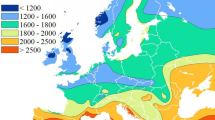Abstract
The present contribution offers evidence regarding the possibility of obtaining reasonable photovoltaic power forecasts without using weather data and with simple data-driven models. The lack of weather data as input stems from the fact that the constant obtainment of forecast weather data might become too expensive or that communication with weather services might fail, but still accurate planning and scheduling decisions have to be conducted. Therefore, accurate one-day ahead forecasting models with only information of past generated power as input for offline photovoltaic systems or as backup in case of communication failures are of interest. The results contained in the present contribution, obtained using a freely available dataset, provide a baseline with which more complex forecasting models can be compared. Additionally, it will also be shown that the presented weather-free data-driven models provide better forecasts than a trivial persistence technique for different forecast horizons. The methodology used in the present work for the data preprocessing and the creation and validation of forecasting models has a generalization capacity and thus can be used for different types of time series as well as different data mining techniques.







Similar content being viewed by others
Notes
This filter can only be used during offline data analysis, due to its acausal nature.
NaN: Not a Number.
To search for reference time series, the PV power time series from all 300 households in the Ausgrid dataset are used.
The floor operator rounds a real number to its preceding integer.
References
Almonacid F, Rus C, Pérez-Higueras P, Hontoria L (2011) Calculation of the energy provided by a PV generator. comparative study: conventional methods vs. artificial neural networks. Energy 36(1):375–384
Chaouachi A, Kamel RM, Nagasaka K (2010) Neural network ensemble-based solar power generation short-term forecasting. JACIII 14(1):69–75
Cococcioni M, D’Andrea E, Lazzerini B (2012) One day-ahead forecasting of energy production in solar photovoltaic installations: an empirical study. Intell Decis Technol 6(3):197–210
Düpmeier C, Stucky KU, Mikut R, Hagenmeyer V (2015) A concept for the control, monitoring and visualization center in Energy Lab 2.0. In: Energy informatics. Springer, pp 83–94
Green MA (2005) Silicon photovoltaic modules: a brief history of the first 50 years. Prog Photovolt Res Appl 13(5):447–455
Hagenmeyer V, Cakmak HK, Düpmeier C, Faulwasser T, Isele J, Keller HB, Kohlhepp P, Kühnapfel U, Stucky U, Waczowicz S, Mikut R (2016) Information and communication technology in Energy Lab 2.0: Smart energies system simulation and control center with an open-street-map-based power flow simulation example. Energy Technol 4:145–162
Li Y, Su Y, Shu L (2014) An ARMAX model for forecasting the power output of a grid connected photovoltaic system. Renew Energy 66:78–89
Mellit A, Pavan AM (2010) A 24-h forecast of solar irradiance using artificial neural network: application for performance prediction of a grid-connected PV plant at Trieste, Italy. Sol Energy 84(5):807–821
Mikut R, Burmeister O, Braun S, Reischl M (2008) The open source Matlab toolbox Gait-CAD and its application to bioelectric signal processing. In: Proc., DGBMT-Workshop Biosignalverarbeitung, Potsdam, pp 109–111
Pearson RK (2002) Outliers in process modeling and identification. IEEE Trans Control Syst Technol 10(1):55–63
Pedro HT, Coimbra CF (2012) Assessment of forecasting techniques for solar power production with no-exogenous inputs. Sol Energy 86(7):2017–2028
Pelland S, Remund J, Kleissl J, Oozeki T, De Brabandere K (2013) Photovoltaic and solar forecasting: state of the art. IEA PVPS Task, vol 14
Rashkovska A, Novljan J, Smolnikar M, Mohorčič M, Fortuna C (2015) Online short-term forecasting of photovoltaic energy production. In: Proc., the Sixth IEEE conference on innovative smart grid technologies (ISGT2015)
Ratnam EL, Weller SR, Kellett CM, Murray AT (2015) Residential load and rooftop PV generation: an Australian distribution network dataset. Int J Sustain Energy, pp 1–20
Shi J, Lee WJ, Liu Y, Yang Y, Wang P (2012) Forecasting power output of photovoltaic systems based on weather classification and support vector machines. IEEE Trans Ind Appl 48(3):1064–1069
Silva Fonseca JG, Oozeki T, Takashima T, Koshimizu G, Uchida Y, Ogimoto K (2012) Use of support vector regression and numerically predicted cloudiness to forecast power output of a photovoltaic power plant in Kitakyushu, Japan. Prog Photovolt Res Appl 20(7):874–882
Tao C, Shanxu D, Changsong C (2010) Forecasting power output for grid-connected photovoltaic power system without using solar radiation measurement. In: Proc., 2nd IEEE International symposium on power electronics for distributed generation systems (PEDG). IEEE, pp 773–777
Ulbricht R, Fischer U, Kegel L, Habich D, Donker H, Lehner W (2014) ECAST: a benchmark framework for renewable energy forecasting systems. In: EDBT/ICDT Workshops. Citeseer, pp 148–155
Waczowicz S, Reischl M, Hagenmeyer V, Mikut R, Klaiber S, Bretschneider P, Konotop I, Westermann D (2015) Demand response clustering-how do dynamic prices affect household electricity consumption? In: Proc., IEEE PowerTech, Eindhoven. IEEE, pp 1–6
Waczowicz S, Reischl M, Klaiber S, Bretschneider P, Konotop I, Westermann D, Hagenmeyer V, Mikut R (2016) Virtual storages as theoretically motivated demand response models for enhanced smart grid operations. Energy Technol 4:163–176
Wirth H, Schneider K (2013) Recent facts about photovoltaics in Germany. Report from Fraunhofer Institute for Solar Energy Systems, Germany
Yang HT, Huang CM, Huang YC, Pai YS (2014) A weather-based hybrid method for 1Day ahead hourly forecasting of PV power output. IEEE Trans Sustain Energy 5(3):917–926
Acknowledgments
The present contribution is supported by the Helmholtz Association under the Joint Initiative “Energy System 2050–A Contribution of the Research Field Energy”.
Author information
Authors and Affiliations
Corresponding author
Rights and permissions
About this article
Cite this article
González Ordiano, J.Á., Waczowicz, S., Reischl, M. et al. Photovoltaic power forecasting using simple data-driven models without weather data. Comput Sci Res Dev 32, 237–246 (2017). https://doi.org/10.1007/s00450-016-0316-5
Published:
Issue Date:
DOI: https://doi.org/10.1007/s00450-016-0316-5




